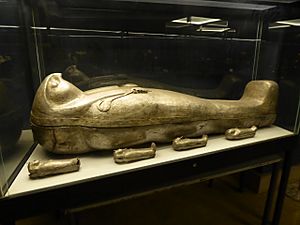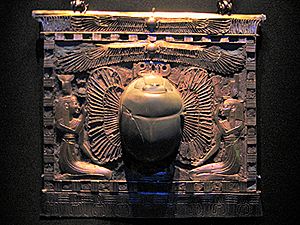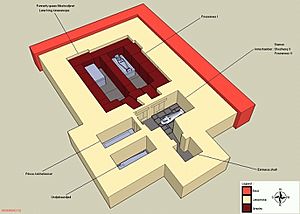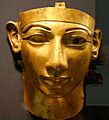Shoshenq II facts for kids
Quick facts for kids Shoshenq II |
|
|---|---|

Gold funerary mask of Shoshenq II in the Cairo Museum
|
|
| Pharaoh | |
| Reign | 887–885 BC (22nd Dynasty) |
| Predecessor | Osorkon I |
| Successor | Takelot I (most likely) or Tutkheperre Shoshenq? |
| Consort | Nesitanebetashru, Nesitaudjatakhet |
| Died | 885 BC |
| Burial | Tanis |
Heqakheperre Shoshenq II, also known as Shoshenq IIa, was an ancient Egyptian pharaoh. He ruled during the Twenty-second Dynasty of Egypt. What makes him special is that his tomb was the only one from his dynasty that was not robbed.
His burial place was found in 1939 by Pierre Montet. It was located inside another king's tomb, Psusennes I, in a city called Tanis. When Montet opened Shoshenq II's coffin, he found many amazing treasures. These included jewel-covered bracelets, special chest ornaments called pectorals, a beautiful silver coffin shaped like a hawk, and a gold mask for his face.
Shoshenq II's royal name, Heqakheperre Setepenre, has a powerful meaning. It means "The manifestation of Ra rules, the chosen one of Ra." This shows his connection to the sun god Ra.
Contents
Who Was Shoshenq II's Family?
Historians are not completely sure about Shoshenq II's parents. There are different ideas about who his father was. Some clues come from items found in his tomb.
Clues from His Tomb
Two bracelets found with Shoshenq II mention King Shoshenq I. A pectoral, which is a type of necklace, was also found. It had the title 'Great Chief of the Ma Shoshenq' written on it. This was a title that Shoshenq I used before he became king. These items might mean that Shoshenq I was his father. However, they could also just be family treasures passed down through generations.
Different Ideas About His Father
Some experts believe Shoshenq II was a younger son of Shoshenq I. They think he lived longer than other kings like Osorkon I and Takelot I. This idea comes from the items in his tomb that name Shoshenq I.
Other scholars, like Karl Jansen-Winkeln, think it's unlikely he was the High Priest Shoshenq C, who was a son of Osorkon I. A study of Shoshenq II's body showed he was in his fifties when he died. This means he could have ruled for a few years after Osorkon I's long reign.
Evidence Against Being Osorkon I's Son
There are reasons to believe Shoshenq II was not the son of Osorkon I.
- His tomb did not contain any items that mentioned Osorkon I. This is unusual if Osorkon I had buried his own son.
- Other kings from this period, like Amenemope and Takelot I, had items in their tombs that named their parents.
- The children of High Priest Shoshenq C (Osorkon I's son) did not give their father royal titles on their own burial items. For example, his son Osorkon called himself "son of the High Priest Shoshenq," not "King's Son." This suggests Shoshenq C was not a king.
Because of this, many experts now think Shoshenq II was probably a son of Shoshenq I. The items from Shoshenq I found in his tomb would then be family heirlooms.
Shoshenq II's Own Reign
Shoshenq II's burial items, like his silver coffin and jewel pectorals, all show his unique royal name, Heqakheperre. This suggests he was a true king of the 22nd Dynasty, not just a co-ruler.
Many Egyptologists, including Jürgen von Beckerath, believe Shoshenq II had his own short reign. They suggest he ruled for about 1 to 2 years. Some place his reign between Takelot I and Osorkon II. Others, like Thomas Schneider, place him between Osorkon I and Takelot I.
The fact that his coffin was made of silver is very important. Silver was much rarer and more valuable than gold in ancient Egypt. This shows how powerful and wealthy Shoshenq II was.
Death and Burial of Shoshenq II

Medical studies of Shoshenq II's mummy show that he died from a serious infection. This infection came from a wound on his head.
His final resting place in Psusennes I's tomb was not his original burial site. Scientists found signs of plant growth on the bottom of Shoshenq II's coffin. This suggests his first tomb became flooded with water. Because of this, he and his treasures were moved and reburied in Psusennes I's tomb.
Images for kids
See also
 In Spanish: Sheshonq II para niños
In Spanish: Sheshonq II para niños







